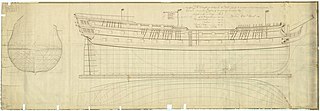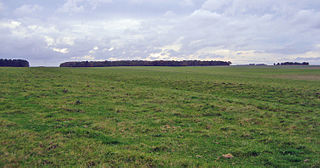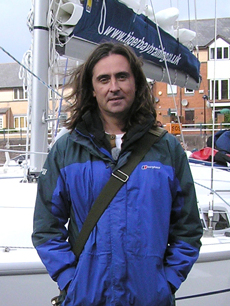Related Research Articles

One Foot in the Grave is a British television sitcom written by David Renwick. There were six series and seven Christmas specials over a period of ten years from early 1990 to late 2000. The first five series were broadcast between January 1990 and January 1995. For the next five years, the show appeared only as Christmas specials, followed by the sixth and final series in 2000.

The Battle of Culloden was the final confrontation of the Jacobite rising of 1745. On 16 April 1746, the Jacobite army of Charles Edward Stuart was decisively defeated by a British government force under Prince William Augustus, Duke of Cumberland, on Drummossie Moor near Inverness in the Scottish Highlands. It was the last pitched battle fought on British soil.

In archaeology, excavation is the exposure, processing and recording of archaeological remains. An excavation site or "dig" is the area being studied. These locations range from one to several areas at a time during a project and can be conducted over a few weeks to several years.

The siege of Yorktown, also known as the Battle of Yorktown and the surrender at Yorktown, began September 28, 1781, and ended on October 19, 1781, at exactly 10:30 am in Yorktown, Virginia. It was a decisive victory by a combined force of the American Continental Army troops led by General George Washington with support from Marquis de Lafayette and French Army troops led by Comte de Rochambeau and a French naval force commanded by Comte de Grasse over the British Army commanded by British Lieutenant General Charles Cornwallis.

The Battle of Killiecrankie, also known as the Battle of Rinrory, took place on 27 July 1689 during the 1689 Scottish Jacobite rising. An outnumbered Jacobite force under Sir Ewen Cameron of Lochiel and John Graham, Viscount Dundee, defeated a government army commanded by General Hugh Mackay.

Avebury is a Neolithic henge monument containing three stone circles, around the village of Avebury in Wiltshire, in southwest England. One of the best known prehistoric sites in Britain, it contains the largest megalithic stone circle in the world. It is both a tourist attraction and a place of religious importance to contemporary pagans.

HMS Colossus was a 74-gun third-rate ship of the line of the Royal Navy. She was launched at Gravesend on 4 April 1787 and lost on 10 December 1798. During her years of service she participated in the Battle of Groix, the Battle of Cape St Vincent, and the Battle of the Nile. While carrying wounded from the latter, she was wrecked at the Isles of Scilly. The wreck is a Protected Wreck managed by Historic England.

Cursuses are monumental Neolithic structures resembling ditches or trenches in the islands of Great Britain and Ireland. Relics found within them indicate that they were built between 3400 and 3000 BC, making them among the oldest monumental structures on the islands. The name 'cursus' was suggested in 1723 by William Stukeley, the antiquarian, who compared the Stonehenge cursus to a Roman chariot-racing track, or circus.

Kit's Coty House or Kit's Coty is a chambered long barrow near the village of Aylesford in the southeastern English county of Kent. Constructed circa 4000 BCE, during the Early Neolithic period of British prehistory, today it survives in a ruined state.
Hornchurch Country Park is a 104.5-hectare park on the former site of Hornchurch Airfield, south of Hornchurch in the London Borough of Havering, east London.

In archaeology, survey or field survey is a type of field research by which archaeologists search for archaeological sites and collect information about the location, distribution and organization of past human cultures across a large area. Archaeologists conduct surveys to search for particular archaeological sites or kinds of sites, to detect patterns in the distribution of material culture over regions, to make generalizations or test hypotheses about past cultures, and to assess the risks that development projects will have adverse impacts on archaeological heritage.

Coast is a BBC documentary series first broadcast on BBC Two television in 2005. It covers various subjects relating to both the natural and social history of the British coastline and also more recently, that of Britain's near neighbours. The seventh series followed a different format from previous series. In 2016, reports from the show were repackaged as Coast: The Great Guide, an eight part series on BBC Two.

Gueudecourt is a commune in the Somme department in Hauts-de-France in northern France.
Trout tickling is the art of rubbing the underbelly of a trout with fingers. If done properly, the trout will go into a trance after a minute or so, and can then easily be retrieved and thrown onto the nearest bit of dry land.
Charley's War was a British comic strip about the First World War, written by Pat Mills and drawn by Joe Colquhoun.

Battlefield archaeology is a sub-discipline of archaeology which studies the material remains and topography of a battlefield to understand a conflict. Archaeological battlefields consist of skirmishes, sieges, camps, and training sites. The study of the relationships and contexts of the material by-products of war give an alternate account to the version recorded in a history book, poem, or witness account, which may be constructed though bias, or may present only a limited perspective of the events. Examination of these locations gives insight to what tactics were being used, weapon modifications, and battle formations. It is not considered distinct from Military archaeology or Recceology.

Neil Oliver is a Scottish television presenter and author. He has presented several documentary series on archaeology and history, including A History of Scotland, Vikings and Coast. He is also an author of popular history books and historical fiction.
Tony Pollard is an archaeologist specialising in the archaeology of conflict. He is Professor of Conflict History and Archaeology at the University of Glasgow, where is based in the Scottish Centre for War Studies and Conflict Archaeology. He academic lead and an archaeological co-director of the charity Waterloo Uncovered. He was the co-presenter of the BBC series Two Men in a Trench, co-founder of the Journal of Conflict Archaeology, and guest expert on Time Team.

The Battle of Littleferry took place during the Jacobite rising in 1746, just before the Battle of Culloden. Scottish forces loyal to the British-Hanoverian Government defeated a Scottish Jacobite force.
Three Men in a Boat is a television comedy/documentary series produced by Liberty Bell Productions for BBC Two starring Dara Ó Briain, Rory McGrath and Griff Rhys Jones, first shown on 3 January 2006. In this first rendition, the three participants rowed in a replica wooden skiff from Kingston upon Thames to Oxford.
References
- ↑ Powell, Eric A. (2003). "Buddy Pictures". Archaeology. 56 (1): 58. JSTOR 41779118.
- 1 2 Pinkowski, Jennifer (2004). "Battlefield U.K." Archaeology. 57 (4): 60. JSTOR 41780928.
- ↑ "Two Men in a Trench - Episode Guide". www.tv.com. November 2018. Retrieved 2018-11-26.
- ↑ Brundle, Anne (September 2003). "Two Men in a Trench". Scottish Archaeological Journal. 25 (2): 196–197. doi:10.3366/saj.2003.25.2.196. JSTOR 27917521.